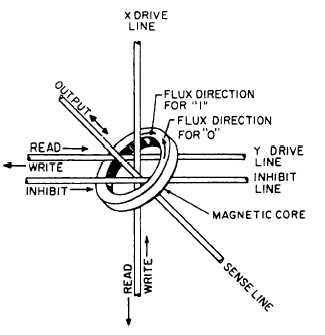and other data that are to be used in the calculations.
The process by which these instructions and data are
read into the computer is called loading.
The first step in loading instructions and data into
a computer is to manually place enough instructions
into memory by using the console or keyboard. These
instructions are then used to bring in more
instructions as desired. In this manner, a few
instructions are used to “bootstrap” more instructions.
Some computers use an auxiliary (wired) memory,
which permanently stores the bootstrap program,
thereby making the manual loading unnecessary.
These instructions may be stored in chips. These
chips are referred to as “read only memories” or
ROMs.
The memory section of a computer is essentially
an electronically operated file cabinet. It is actually a
large number of storage locations. There are
generally between 1 and 40,000 locations. Each one
is referred to as a storage address or register. Every
computer word that is read into the computer during
the loading process is stored or filed in a specific
storage address and is almost instantly accessible.
The types of memory storage devices used most
frequently in present-day computer technology are
magnetic cores, semiconductor, thin film, magnetic
drum, magnetic tape, and magnetic disks.
Magnetic Cores
One of the methods for storing internal data in a
computer is realized by using magnetic cores. Cores
are generally constructed by two methods. The first
type of core, called a tape wound core, is fabricated
by wrapping a tape of magnetic material around a
nonmagnetic toroidal form. A toroid is a term used to
describe a doughnut-shaped solid object. The second
type of core is called a ferrite core, and it is made by
molding finely ground ferrite into a toroidal form.
The ferrite used in this application is a ceramic iron
oxide possessing magnetic properties. The ferrite
particles are then heat-fused or “sintered” by the
application of heat and pressure.
In magnetic core memories, each data bit is stored
in the magnetic field of a small, ring-shaped magnetic
core (fig. 8-2). Magnetic cores generally have four
wires running through them. Two wires are used for
READ selection. These same two wires are used for
WRITE by reversing the direction of current flow. An
inhibit wire prevents writing a 1 when a 0 is to
written. The sense wire picks up the signal voltage
generated by the shifting of core from 1 to 0 in a
READ cycle.
Since a single core stores only one bit of a word,
a large number of cores are required to handle all the
bits in every word to be stored. These cores are
arranged in arrays to assign memory address locations
and quickly write data and locate data for read-out
purposes. The technique used most frequently for
writing and reading data in magnetic core arrays is
known as the coincident-current technique.
In computer memory applications, the ferrite core
is magnetized by a flux field produced when a current
flows in a wire (drive line) that is threaded through
the core. The core retains a large amount of this flux
when the current is removed. Flux lines can be
established clockwise or counterclockwise around the
core, depending on the direction of the magnetizing
current. A current in one direction establishes a
magnetization in a given direction. Reversing the
direction of the current flow reverses the direction of
the flux field and the core magnetization. These two
unique states represents 0 and 1, respectively.
Semiconductor Memories
Semiconductor memories are used in many
modern computers.
Most of the semiconductor
memories are of the MOS LSI type, which may be
Figure 8-2.-Magnetic core showing X, Y, inhibit, and sense
lines.
8-6

